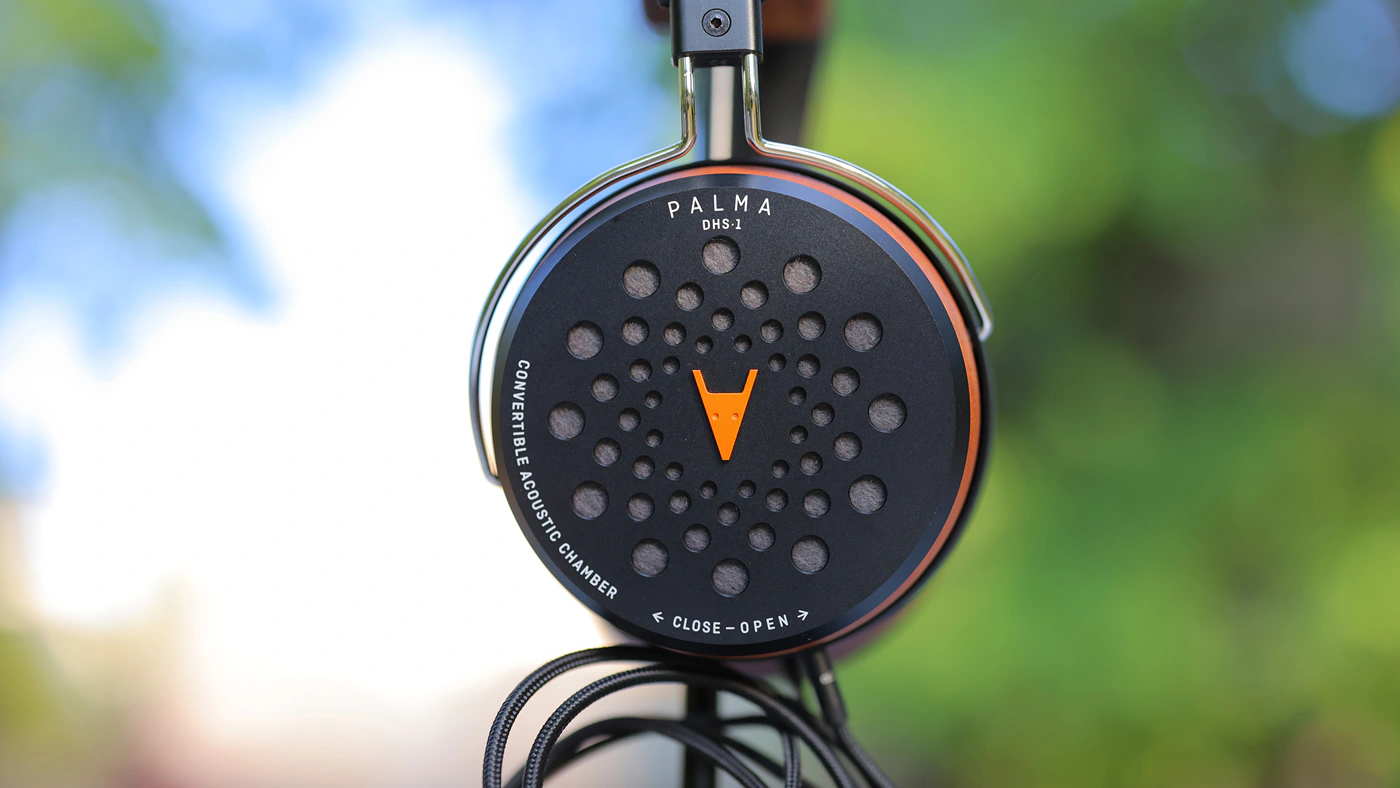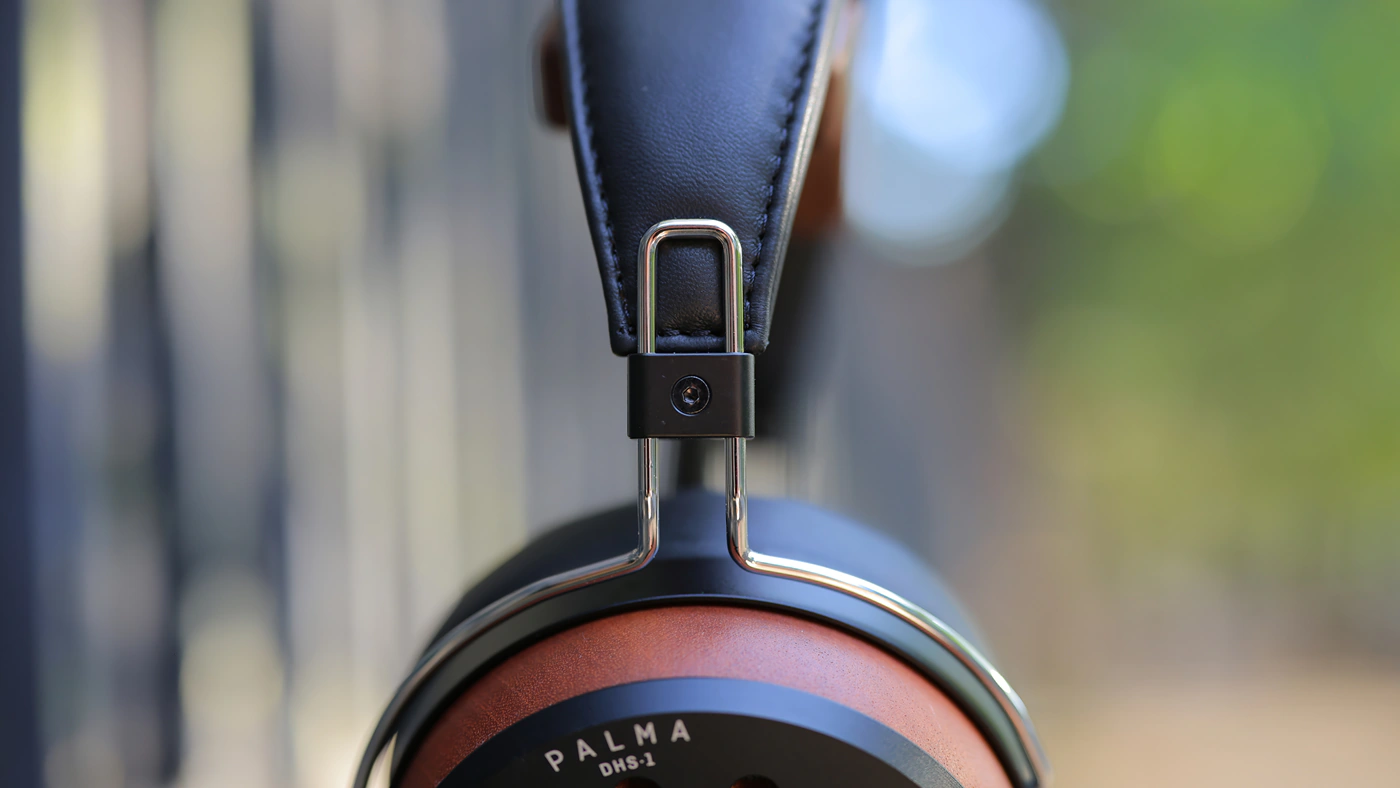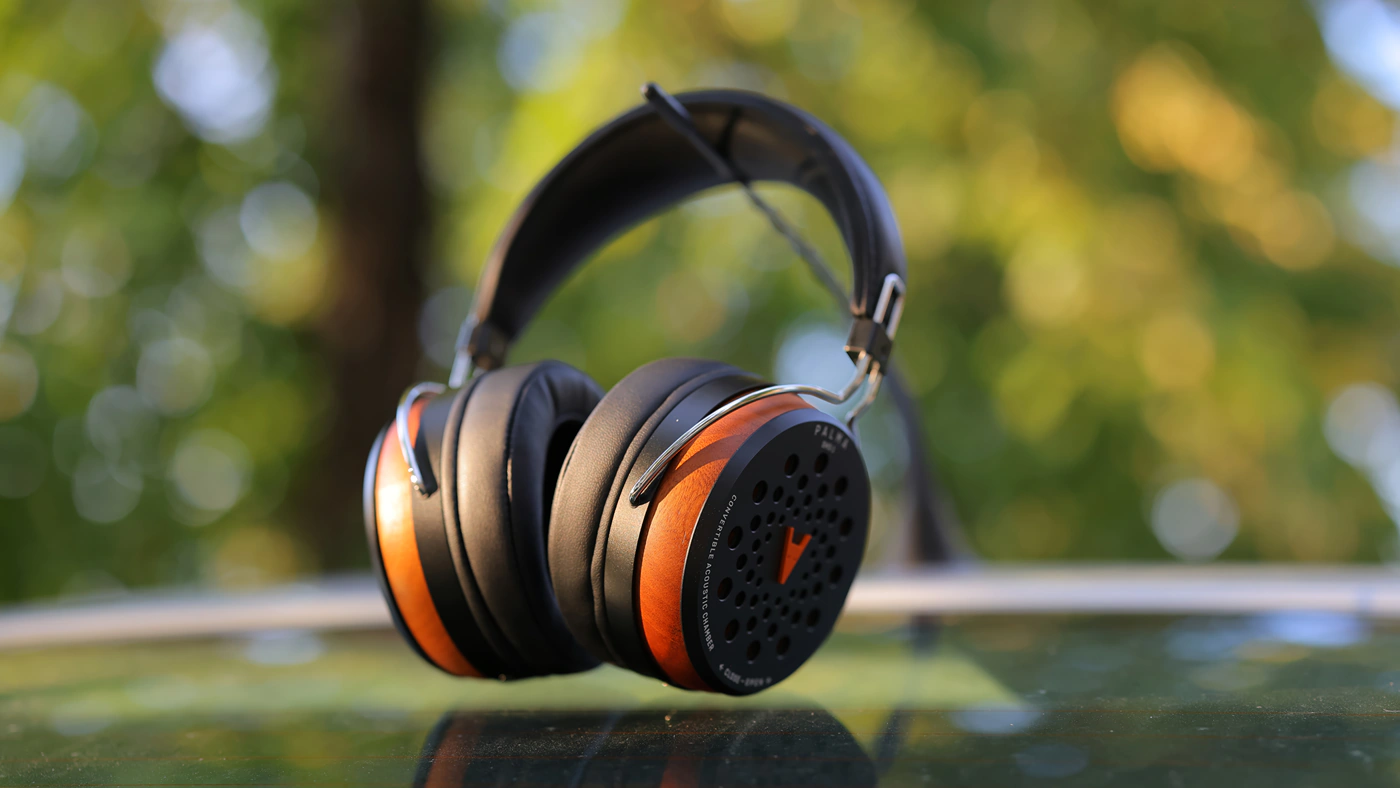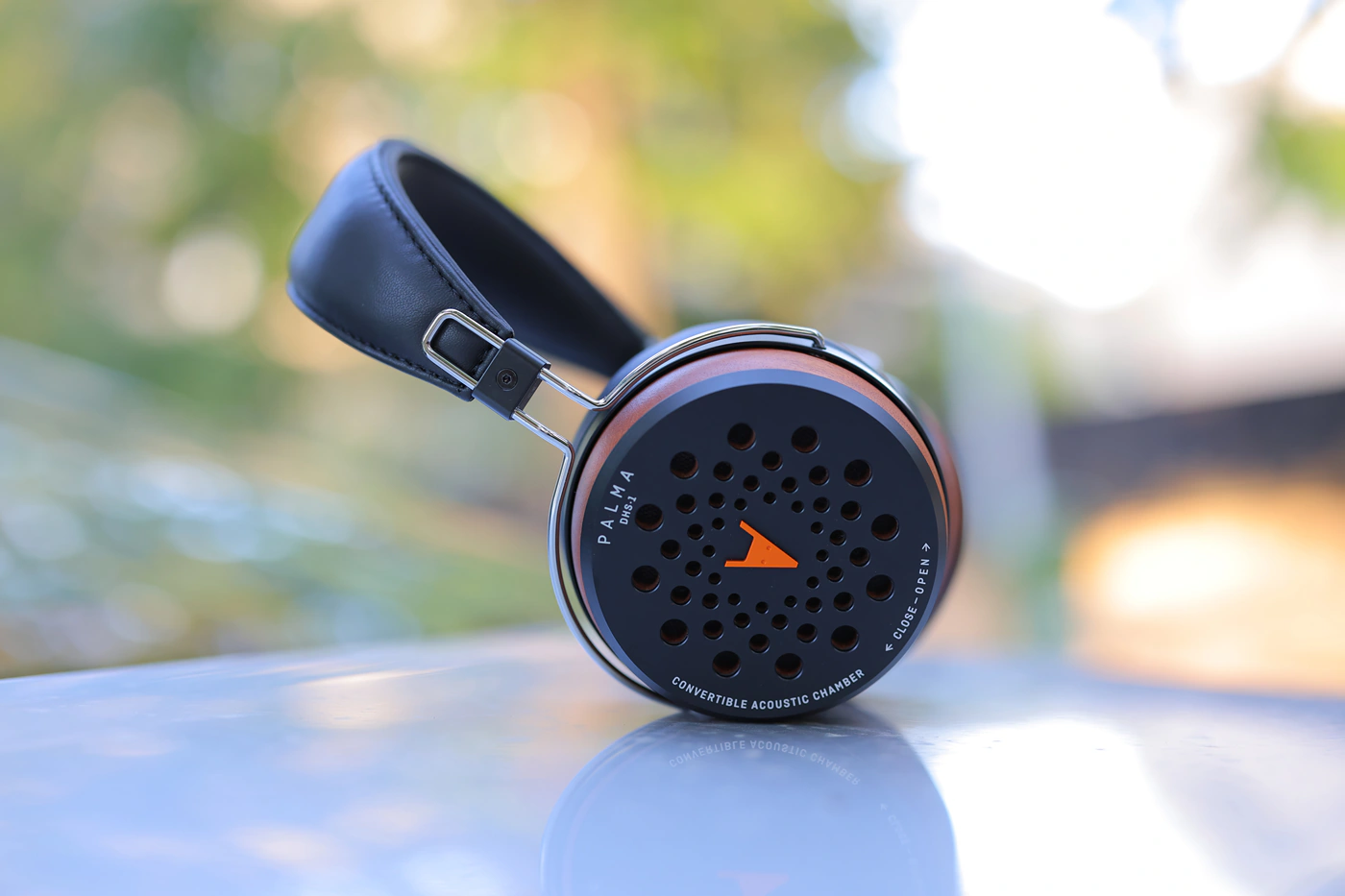Palma DHS-1 Convertible HiFi Headphones – Bleeding Edge Music Innovation
Palma DHS-1 is the $2195 USD / 2195 EURO World’s First Headphones that have a convertible design allowing you to switch between a closed-back and open-back design. Today we will review the DHS-1 and compare them the most relevant and best sounding flagship headphones we’ve reviewed to date, including Dan Clark Expanse (3999 USD), Crosszone CZ-8a Enhanced (1700 USD), HIFIMAN Audivina (1999 USD).

Introduction
Palma is an upcoming company from Europe, Spain. Their first headphone is a true total innovation in the world of music and headphones, and DHS-1 has the title of being the first convertible headphone in the whole world, allowing you to quickly switch between a closed back and an open-back headphone. They are available for order now, and you can purchase one on the Palma official website. As an Amazon Influencer-, I earn from qualifying purchases, and using the purchase links in my reviews helps me maintain this website and Youtube Channel. Huge thanks to Palma for providing the sample for this review, in exchange for my honest opinion.
PROs – Excellent comfort, thick and dense earpads that offer excellent contact and seal, two sonic modes which are equally reliable, and a beautiful, sturdy construction. Sonically, DHS-1 is exceptionally versatile, very dynamic and punchy, with a natural midrange and excellent overall resolution / detail, but also a wide and holographic soundstage, and strong instrument separation, fit to be called a true flagship. When in open mode, it is literally one of my favorite headphones sound-wise, and considering my collection, this is saying a lot.
Cons – 2.5mm cable connectors at the headphone side.
Product Link
Official Store – https://www.palma.audio/en/home/
Build Quality / Aesthetics
Palma DHS-1 is a headphone committed to evolution, refinement of technology and to offer something new to demanding audiophiles. The idea behind those headphones is to offer the best of both the closed-back and the open-back worlds, by having a moving earcup plate that can quickly switch between the two. You can basically simply slide the smooth mechanism on the earcup even while wearing the DHS-1 so swap between the open-back and the closed-back modes, effectively converting the DHS-1 like you’d do with a sports car.

The Closed Mode is more of a semi-open mode in my experience, and it will significantly reduce the leakage compared to the Open Mode, but the passive noise isolation is very similar between the two modes. The idea is that you could enjoy music at moderate volumes in public spaces using the closed mode, then go at home and blast the DHS-1 in the Open Mode for a more dramatic signature.

As we all know, the sound from a dynamic driver, as the one used in the Palma DHS-1, will move both in the forward direction, towards your ears, but also backwards, towards the earcup / diffuser / room. Most closed-back headphones have to take advantage of this, because in the closed-back mode your ears will perceive both the forward sound, but also the sound coming from the back of the driver, which bounces off the back plate, and which arrives with a slight delay. The sonic performance is worse if the delay is longer, and as we’ve seen people don’t like an after ringing or echo, and will perceive it as fatiguing as was the case in undampened headphones like Ultrasone Signature Studio, so Palma dedicated a lot of effort to keep this time as low as possible, managing to keep it at less than 0.1 milliseconds.

Using the headphones in the open mode will result in 80% lower unwanted reflected waves, which will be perceived as a cleaner, more defined sound, and is a big reason why most people prefer open-back headphones sonically. The frequency response of the Palma DHS-1 is almost a flat line, and very similar between the closed-back and open-back modes, with only very minor changes, so you can expect a very similar tuning. The SPL in Open Mode is 102 dB / mW, with a THD of 0.06% at 110 dB, so almost at maximum listenable volume, while the Closed Mode will increase the Sensitivity to 104 dB / mW, but also increase the THD to 0.08% for 110 dB volume. This THD is actually incredibly low as it is measured at an actually loud volume, completely different from what most companies measure, which is typically the THD at low volumes or with low loads.

At the heart of the Palma DHS-1 we have a 50mm dynamic driver, with the central dome made of rigid cellulose, a suspension ring made of ultra-thin polyamide, and a 26mm diameter voice coil, the whole composite membrane being 50mm in size. We know that amplifiers with a high damping factor sound awesome, as we’ve explored in many previous reviews, but Palma designed the DHS-1 to sound excellent with amplifiers that don’t have a high damping factor, so the driver assembly has a low impedance and low inductance, to pair well with more affordable AMPs.

The wooden parts of the earcups are made of African Sapele wood, having beautiful reddish tones and loved for its sonic characteristics. The whole headband and earpad design promises excellent comfort, and as we will explore, they actually achieve this by having a really soft and thick earpad, and also a super comfy to use.
Fit / Comfort
Wearing the DHS-1 feels like a little heaven on my ears, but I have to admit that the thick and dense earpads take around 5 minutes to warm up and become a bit softer, after which the comfort is quite a bit better than the first second you put them on your head. The passive noise isolation is not strong regardless of the mode used, and both modes leak about the same, which is lower than a full open-back headphone like HIFIMAN HE1000SE, but much more than a fully closed-back model.

Palma includes a rather thin and flexible cable with the DHS-1, and the connector at the headphone side is a 2.5mm mono connector, so aftermarket cables might be a bit tricky to find, yet this cable is good at canceling microphonic and handling noise and helps with the comfort of the DHS-1. The main reason you would ever want aftermarket cables with the DHS-1 is for convenience, as they come with a rather short balanced cable, and for a full-sized headphone to use at my desk, at 1.2 meters, it is quite short.

Each individual headphone is measured and you receive a lovely frequency response with your headphone, although the SPL Meter is really compact, so it is very zoomed out. The most important parts are there, the response is almost a straight line, with a minor dip at 4 kHz, which is not audible in person. I love the fact that changing between open and closed is seamless and can be done while wearing the Palma DHS-1, all is very satisfying and feels well-made with them.

The weight of the DHS-1 is theoretically high, at 490 grams, without the cables, but the earpads make such good contact with my ears, and the headband has such a soft design and dense padding that I physically do not feel the weight, they feel substantial and well made but never heavy. The clamping force is very natural, DHS-1 does not swivel laterally, and all lateral swivel is provided by the headband, but the dense and thick earpads ensure excellent wearing comfort. We get a confirmation from the manual that the drivers used are 50mm electrodynamic drivers, and the impedance is a very natural 32 OHM impedance. The quoted frequency response is noted to be 5 Hz – 30 kHz for the Open Mode and 10 Hz – 30 kHz for the Closed Back Mode. Something I have noticed while using the DHS-1 is that the bass is indeed stronger and deeper if using them in the closed-back mode, which is both surprising and confirms my theory that using closed back headphones does not inherently increase bass extension.

Palma believes strongly in their headphones, and DHS-1 is covered by a 2-Year Warranty, and the headphones are patented under the European Patent EP23383080.1. My take is that you’re unlikely to ever need service, and the only part that I believe could be upgraded is the cable for a longer one, which is an aftermarket purchase, or the headband, in case Palma designs a new one, for someone who has a larger or a smaller head. For my medium-sized head, I have the sizing on the DHS-1 at 70% of maximum size, so they will fit someone with a smaller head just fine, but someone with a bigger head might need a larger headband.
Overall, the comfort is excellent, I love wearing the DHS-1, it is a superb headphone for my usage, comfy pads, short cable, not a strong passive noise isolation and an average leakage level, but an exceptionally sturdy build quality, that’s better than the average high-end headphone I’ve seen to date.
Sound Quality
Pairings – To drive the Palma DHS-1, I have paired it with HIFIMAN EF400, Feliks Audio Euforia Evo driven by Dethonary Listening M1, Singxer SA-1 V2 driven by SMSL DO200 PRO, iBasso D16 and PB5, and also with lower power sources, including IKKO ITX05, iBasso DC07 PRO, and even DAPs like iBasso DX180. It is very easy to drive the Palma DHS-1 and they are not picky with the source. You never hear background noise, and the sonic performance is exceptionally consistent across sources, so you never have to worry about what the combo will sound like, DHS-1 is not easily influenced by the source.

Overall Signature – Palma DHS-1 has a uniquely detailed, wide but natural sound. There is a complete transparency in the midrange, and one of the things I think the company did best is offer an exceptional performance in both the open and closed mode, with no real preference or tilt towards one or the other. Basically, with DHS-1 you will have fun with all sources, all music, and regardless of how you use them. With a deep and low-reaching bass, and a naturally extended treble that can reach 20 kHz just fine, but is refined, smooth and silky, and a perfect voicing for both male and female singers, DHS-1 is not a novelty factor headphone, but actually has the sound of a true flagship to back up the idea of innovation that is infused in a convertible headphone. The voicing is generally so forward and such a central element of the sound that you could call the DHS-1 a vocal – mid centric – natural headphone. I’ve seen someone write this, but DHS-1 would be downright excellent for studio usage, mixing, mastering and music production, especially in the tighter, faster and more acute Closed Mode, you really hear everything and in that studio, linear mode.
Convertible Closed-Back / Open-Back – Although the biggest selling point of the DHS-1 is that you can use them both open-back and closed-back, you can expect a very similar signature, especially in the midrange. The biggest difference can be heard in basically everything, when you set them to open-back, the sound is a bit more v-Shaped, the bass is deeper, treble brighter and more sparkly, the soundstage is wider, deeper and the whole sound is more dynamic and engaging. The Closed-Back or Semi-open tuning is basically a very neutral – linear – flat presentation that’s studio and perfectly true-to-the-recording, while the open-back signature is a true-to-life take that sounds exactly like a live concert would sound like.

Bass – Opening the scene with true depth and a bass that can reach 20 Hz, the low-end of the Palma DHS-1 is fairly natural, it doesn’t color the whole tuning with too much or too little, it presents what is actually present in the recording, both in the heavy tracks and in the lighter tracks as well. DHS-1 doesn’t cut any of the extension, but bass is generally a natural – fast impact and body for an instrument, and not a leading / central element in most songs.

Midrange – Mids are the most beautiful part of the DHS-1 sound, with a really spot-on texture and tonality for both male and female voices, excellent resolution and detail. You can hear micro textures, micro details and information that is generally overlooked by most headphones, and yet DHS-1 will make it obvious, but not push it too much, the tuning is a truly refined smoother take on the highly revealing sound you expect from a flagship. This means that the grain level is zero, but the engagement / punchiness is set at max. The more I listen to the DHS-1 the more I love its voicing, both in the open-back and the closed-back mode, the precise, bleeding-edge and fast sound in the closed-mode is simply perfect, while the impressionistic, emotional and wide / holographic sound in the open mode is colorful, and emotional, giving all music a really open and true-to-life presentation.

Treble – To top off the colorful and vivid sound, Palma designed the DHS-1 to extend up to the high heavens in the treble but also made it all silky and smooth like heaven would actually sound like, giving them a refined, rich and pleasing sound that can forgive a brighter or harsher sounding album, but still reveal all the information and the detail that was captured during the recording and allowed to remain in the mixing and mastering process. You will often be flabbergasted at the level of resolution, detail and clarity that DHS-1 can present you, and at how crisp, detailed and simply stunning they can sound, but you’ll also love how it never gets fatiguing, tiring or busy.

Dynamics – You ain’t never heard true dynamics, punch and kick if you haven’t heard Palma DHS-1, they can easily handle extremely compressed and busy music without ever giving you a clue that your song is actually busy. Dynamics handling is excellent, but it is much better if you’re using the open mode, as the closed / semi open mode is flatter and more precise, while the semi open / open mode allows more energy and emotion to shine through.

PRaT / Textures – Palma DHS-1 has a uniquely rich, well-defined texture that reveals micro details in each and each instrument. There’s a strong sense of space and separation, but each instrument has a unique timbre and texture, they all feel real, and this extends to both guitars, blowing instruments, bowed instruments, but synths are also crispy and textured, rendering a strong feeling of realism.
Loudness Saturation Gradient – Control is great, even at more than 120 dB and extremely loud volumes, but the sound is generally more balanced, more mid centric at very low volumes, it is more natural and open, more airy at medium volumes, and becomes forward and aggressive at extremely loud volumes. Quite unique in the tuning, DHS-1 goes from a slightly intimate and friendly player, to an open orchestra, to a live concert in this order, from quiet to very loud.

Soundstage – The soundstage changes quite a bit between the Closed and the Open modes, and it is holographic, wide and deep in the Open Mode, but more linear, precise and with a stronger instrument separation in the closed mode. I actually did not want to write this paragraph like this, so I triple tested, this is simply how it changes relative to the two sonic modes.
Comparisons
Palma DHS-1 vs Crosszone CZ-8a Enhanced (2195 USD vs 1700 USD) – CZ-8a Enhanced is a unique headphone that is semi open, and for a stronger passive noise isolation and less leakage, it surely is a choice over the DHS-1 which will isolate less and leak more regardless of the open or closed configuration. This being said, DHS-1 is much easier to drive and it is far less picky with the source, while CZ8a Enhanced will only sound nice with very specific sources. Comfort is top notch with both, as both have dense and thick earpads, but DHS-1 despite being heavier, will feel lighter. The cable is not universal for either, and it will be hard to get either to work with aftermarket cables, as the 2.5mm mono jacks of the DHS-1 are as rare as the 4-Pole 3.5mm jacks that CZ-8a enhanced uses.
The sound of the CZ-8a Enhanced is unique, has a colored signature that’s hard to even describe, having a forward midrange, smooth and silky treble and a fairly bloomy and thick bass which is on the slower side, creating a really satisfying oomph in music, but less impact. DHS-1 sounds natural, produces a really clean voicing and has more details in the midrange and the bass, although the bass is more neutral and less warm than that of the CZ-8a enhanced. Both headphones handle classical and orchestral music really nicely, but DHS-1 can handle rock, pop and modern EDM quite a bit better, having a deeper bass, more separation between instruments and better rendering of dynamics in busy songs. I have always been saying this, but CZ-8a Enhanced is basically made for classical music, Jazz and even orchestral, while DHS-1 is a modern headphone that handles everything really well.

Palma DHS-1 vs Dan Clark Expanse (2195 USD vs 3999 USD) – Expanse is almost double the price of the DHS-1 but based on popular demand, I decided to replace HE1000SE with Expanse for this comparison, and Expanse is made with a really high-end design in mind, has a tiger clamping force, but denser earpads, and a different headband that allows the headphone to auto-adjust, compared to Palma DHS-1 which needs to be manually adjusted for the perfect fit. The cables of both headphones are proprietary, but somehow it was easier to find adapters and aftermarket cables for Expanse, as the DCA standard is a bit more popular than the 2.5mm mono jacks found on the earcups of the DHS-1. Both headphones leak about as much, while DHS-1 isolates a bit more from the outside noise. Expanse is far harder to drive, needs a powerful amplifier and lots of power to be driven well, while DHS-1 can sound sweet and juicy even when powered by a dongle portable adapter.
Sonically, Expanse is a bit more forward, expands wider and deeper in the soundstage, but both headphones have a similar level of dynamics and clarity. Expanse can resolve certain details and micro details a bit more, while DHS-1 can reproduce a slightly more emotional female voice, Expanse having an equally engaging presentation for male and female voices. Both headphones sound really nice, and you really won’t go wrong with either, and with DHS-1 sounding more dynamic and vivid in the Open Mode, you’ll likely be using both Open, so the advantage of Expanse for having a slightly better definition and more resolution should be weighted against the price difference, Palma DHS-1 can transform between a monitoring / neutral headphone in the closed-back mode, to an audiophile wide and dynamic headphone in the open mode, so both are really interesting, DHS-1 even has a similar tuning and signature, but is more affordable, while Expanse is a flagship variant, but for a fair price increase.

Palma DHS-1 vs HIFIMAN Audivina (2195 USD vs 1999 USD) – Audivina is larger and a bit lighter, but the fitting and the more dense earpads of the DHS-1 make it a bit more comfortable. Audivina is the only closed-back headphone we have in the comparison list, but both DHS-1 and Audivina have an average passive noise isolation, both leak a natural amount of sound and both are generally great if used at medium volumes but people around will know if you’re blasting a rock concert in your headphones. Audivina is more picky with the source, requires more power and is harder to match, while DHS-1 is much easier to match and will sound better across multiple sources. Both headphones come with an average cable, but the transport case of the DHS-1 is a nice premium.
Judging the sound of both, Audivina has a more colored sound, it can sound peaky and plasticky at times, especially in the midrange, while DHS-01 has a perfect sound, they always sound natural in the midrange. The treble is sharper, brighter and more revealing as presented by Audivina, while DHs1 sounds more dynamic and more vivid, especially in the midrange. You can’t really go wrong with either headphone, and both will offer exceptional resolution and details, but Audivina sounds wider, especially in the lateral plane with a stronger instrument separation, while DHS1 sounds deeper, has a more juicy and punchy sounding midrange, and a more pleasing tonality, all while bringing music a bit closer together, and creating the feeling of a rock concert better. While Audivina sounds like a large concert hall, Palma DHs-1 sounds like a really engaging metal festival.
Value and Conclusion
Starting with a price tag that is not cheap, the headphones are not cheap either, and for a model that delivers a first in the whole world, Palma surely isn’t expensive, and development costs money, but Palma made it possible to own a crossover headphone for the audio aficionado who wants to have the ultimate development in the audio world.

Award – Before the end of the day, I will be adding the Palma DHS-1 to the Audiophile-Heaven Hall Of Fame, for offering both an exceptional performance in the sound, comfort, ergonomics, and ultimately delivering true innovation, including the crossover between closed and back, but also an excellent sound in both modes.

At the end of the day Palma DHS-1 is an excellent headphone and more, offering two headphones in one, extreme dynamics, excellent resolution, and also a comfortable, well-made headphone. While a flagship and priced as such, DHS-1 is what true innovation and excellent sonics look like, a headphone you really have to hear at least once to believe such performance exists.
Product Link
Official Store – https://www.palma.audio/en/home/
--- Please remember to stay safe, and always have fun while listening to music!---
- If you have a dime to spare, please donate, and help us! It would make the day brighter for me and my wife-
Full Playlist used for this review
We listened to more songs than those named in this playlist, but those are excellent for identifying a sonic signature. I recommend trying most of the songs from this playlist, especially if you’re searching for new music! The playlists are different for Spotify, Tidal and Youtube, and based on the songs I enjoy and are available on each!
https://www.youtube.com/playlist?list=PL_cjBXGmwSHSdGcwuc_bKbBDGHL4QvYBu
https://open.spotify.com/playlist/5J3oloz8Riy9LxEGenOjQ0?si=979ba4f082414be7
https://tidal.com/browse/playlist/330fd544-8e5b-4839-bd35-676b2edbb3d5
--- Contact Us ---





